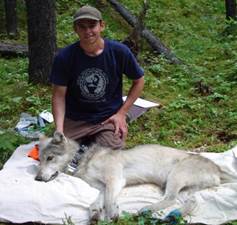Density, demography, and functional response of a harvested wolf population in west-central Alberta, Canada
 Across their range in North America, wolves exist in landscapes heavily managed by humans. In most areas, humans have altered natural habitats, competed with wolves for ungulate prey, and manipulated wolf populations directly through liberal harvest regimes. Ironically, few research studies have explored wolf ecology in managed landscapes, and techniques used to monitor wolves and their impacts on prey populations are ineffective across much of wolf range. I addressed limitations associated with gathering information that is critical for both the management and conservation of wolves and their prey, and explored the population dynamics and prey relationships of an intensively managed wolf population. I developed a novel approach for surveying wolves using an occupancy-abundance model derived from sightings of wolf tracks, and found a positive relationship between wolf density and the occupancy of sample units by wolf tracks. I extended recent work on using GPS collar technology to estimate kill rates of wolves in forested landscapes and found that statistical clustering techniques identified the majority of wolf kills, but field visitation of these sites is required to accurately measure kill rates. I used estimates of prey density and wolf kill rates to model the functional response of wolves and found that the size of wolf packs and landscape features influence relationships between wolf kill rates and prey abundance. Finally, I modeled the potential impact of harvest mortality on a wolf population in west-central Alberta and found that low natural mortality and emigration, coupled with high pup production, allowed wolves to sustain liberal harvest regimes. I discussed the relevance of my findings to predator-prey theory, and provided recommendations to biologists managing wolves and their prey.
Across their range in North America, wolves exist in landscapes heavily managed by humans. In most areas, humans have altered natural habitats, competed with wolves for ungulate prey, and manipulated wolf populations directly through liberal harvest regimes. Ironically, few research studies have explored wolf ecology in managed landscapes, and techniques used to monitor wolves and their impacts on prey populations are ineffective across much of wolf range. I addressed limitations associated with gathering information that is critical for both the management and conservation of wolves and their prey, and explored the population dynamics and prey relationships of an intensively managed wolf population. I developed a novel approach for surveying wolves using an occupancy-abundance model derived from sightings of wolf tracks, and found a positive relationship between wolf density and the occupancy of sample units by wolf tracks. I extended recent work on using GPS collar technology to estimate kill rates of wolves in forested landscapes and found that statistical clustering techniques identified the majority of wolf kills, but field visitation of these sites is required to accurately measure kill rates. I used estimates of prey density and wolf kill rates to model the functional response of wolves and found that the size of wolf packs and landscape features influence relationships between wolf kill rates and prey abundance. Finally, I modeled the potential impact of harvest mortality on a wolf population in west-central Alberta and found that low natural mortality and emigration, coupled with high pup production, allowed wolves to sustain liberal harvest regimes. I discussed the relevance of my findings to predator-prey theory, and provided recommendations to biologists managing wolves and their prey.